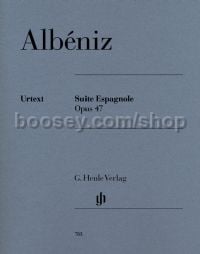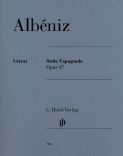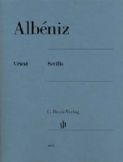Suite Espagnole, Op.47 (Piano)
Suite Espagnole, Op.47 (Piano)
* Estimated price converted from UK retail price
“One closes one’s eyes and is bedazzled by the sheer wealth of invention in this music!” The person who spoke so enthusiastically about Albéniz, one of the founders of the Spanish national style, was none other than Claude Debussy. The “Suite espagnole” for piano is surely his most popular work. It reflects the manifold rhythms and melodies of different Spanish regions – and in the last piece even Cuba is represented.The much loved composition “Asturias” was also included in the collection. This work now joins “Iberia” and the “Chants d’Espagne” in our much renowned series of Albéniz’ piano works.
Preface
The genesis and publication history of the Suite Espagnole, op. 47, by Isaac Albéniz (1860–1909) cover more than one and a half decades. It all began with a recital that the Spanish composer and pianist gave in Madrid on 24 January 1886. Among the pieces he played was a three-movement Suite Spagnole consisting of a Serenata, Sevillana, and Pavana- capricho. The success was so great that Albéniz soon reached an agreement with his publisher, Benito Zozaya, to publish a Suite Espagnole, now expanded to comprise eight movements. Four pieces, nos. 1 to 3 and no. 8, appeared in separate fascicles that very year: Granada (Serenata), Cataluña (Curranda), Sevilla (Sevillanas), and Cuba (Capricho). Two of the pieces, Granada and Sevilla (probably composed in 1882–3), had been heard at his January recital; the other two were newly composed, being dated 14 June and 15 June 1886 in the autograph manuscript. The cover pages of these editions reveal that the titles of the remaining four numbers had already been decided upon; all that was missing was the music. This situation was to remain the same for another fifteen years.
It was not until 1901 that the Suite Espagnole, now indeed consisting of eight pieces, was published as a single collection. To complete the work, however, compositions already published by Albéniz were incorporated. Cádiz (no. 4) had already appeared as Célèbre Sérénade Espagnole, op.181, in 1890. For Asturias (no. 5) the Prélude from his Chants d’Espagne, published as op. 232/1 in 1892, was adopted. The same collection also provided Castilla (no. 7), which had appeared in 1897 as the final piece in that volume with the title Seguidillas. Finally, Aragón (no. 6) was drawn from the first of his Deux Morceaux Caractéristiques, op.164, where it had been published with the title Jota Aragonesa in 1889.
The reason why such a long period of time had to elapse before the decision was made to complete the Suite had to do with the transfer of publication rights from Zozaya to Casa Dotesio in 1900. It is unclear exactly to what extent Albéniz himself was involved in choosing the four new pieces and supervising the publication process, but there is much evidence that his involvement was minimal or nonexistent. The new editions in the Suite Espagnole do not differ significantly from those already published; on the contrary, they are of poorer quality, as they contain several obvious printing errors and oversights. More importantly, the fabric of the music sometimes clashes with the newly chosen title, which would hardly have happened if Albéniz had selected the new pieces himself. The inclusion of the Prélude from Chants d’Espagne, now with the title Asturias, is a clear indication that the composer took no part in the publication process, for the flamenco elements of the Prélude are ill-suited to represent the folk music of Asturias, a region located in northern Spain. Jacinto Torres, in his meticulously researched Catálogo sistemático descriptive de las obras musicales de Isaac Albéniz (Madrid, 2001), has therefore advanced the theory that the choice of this piece probably involved a confusion with the collection Espagne (1899), which, unlike Chants d’Espagne, actually does contain a piece entitled Asturias.
Even if Albéniz no longer took an interest in this collection in the years around 1901 (by then the main focus of his compositional activities had shifted to opera), the Suite Espagnole quickly became so popular outside Spain that it was issued by a German publisher (Hoffmeister in Leipzig) before the onset of the First World War.
In closing, I would like to thank all of the libraries mentioned in the commentary at the end of this volume for kindly placing copies of the sources at my disposal. I am also greatly indebted to Jorge Ferreyra for helping me with the Spanish and for his advice in several matters of piano technique.
Berlin, autumn 2005 - Ullrich Scheideler







